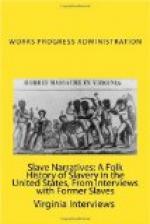“When we cooked our regular meals, we would put our food in pots, slide them on an iron rod that hooked into the fireplace. (They were called pot hooks.) The pots hung right over the open fire and would boil until the food was done.”
“We often made ash cake. (That is made of biscuit dough.) When the dough was ready, we swept a clean place on the floor of the fireplace, smoothed the dough out with our hands, took some ashes, put them on top of the dough, then put some hot coals on top of the ashes, and just left it. When it was done, we brushed off the coals, took out the bread, brushed off the ashes, child, that was bread.”
“When we roasted a chicken, we got it all nice and clean, stuffed him with dressing, greased him all over good, put a cabbage leaf on the floor of the fireplace, put the chicken on the cabbage leaf, then covered him good with another cabbage leaf, and put hot coals all over and around him, and left him to roast. That is the best way to cook chicken.”
Mrs. Cheatam lives with a daughter, Mrs. Jones. She is a very small old lady, pleasant to talk with, has a very happy disposition. Her eyes, as she said, “have gotten very dim,” and she can’t piece her quilts anymore. That was the way she spent her spare time.
Interviewer’s Comment
She has beautiful white hair and is very proud of it.
Submitted December 1, 1937
Indianapolis, Indiana
Ex-Slave stories
District #5
Vanderburgh County
Lauana Creel
James Childress’ story
312 S.E. Fifth Street, Evansville, Indiana
From an interview with James Childress and from John Bell both living at 312 S.E. Fifth Street, Evansville, Indiana.
Known as Uncle Jimmy by the many children that cluster about the aged man never tiring of his stories of “When I was chile.”
“When I was a chile my daddy and mamma was slaves and I was a slave,” so begins many recounted tales of the long ago.
Born at Nashville, Tennessee in the year 1860, Uncle Jimmie remembers the Civil War with the exciting events as related to his own family and the family of James Childress, his master. He remembers sorrow expressed in parting tears when “Uncle Johnie and Uncle Bob started to war.” He recalls happy days when the beautiful valley of the Cumberland was abloom with wild flowers and fertile acres were carpeted with blue grass.
“A beautiful view could always be enjoyed from the hillsides and there were many pretty homes belonging to the rich citizens. Slaves kept the lawns smooth and tended the flowers for miles around Nashville, when I was a child,” said Uncle Jimmie.
Uncle Jimmie Childress has no knowledge of his master’s having practiced cruelty towards any slave. “We was all well fed, well clothed and lived in good cabins. I never got a cross word from Mars John in my life,” he declared. “When the slaves got their freedom they rejoiced staying up many nights to sing, dance and enjoy themselves, although they still depended on old Mars John for food and bed, they felt too excited to work in the fields or care for the stock. They hated to leave their homes but Mr. Childress told them to go out and make homes for themselves.”




